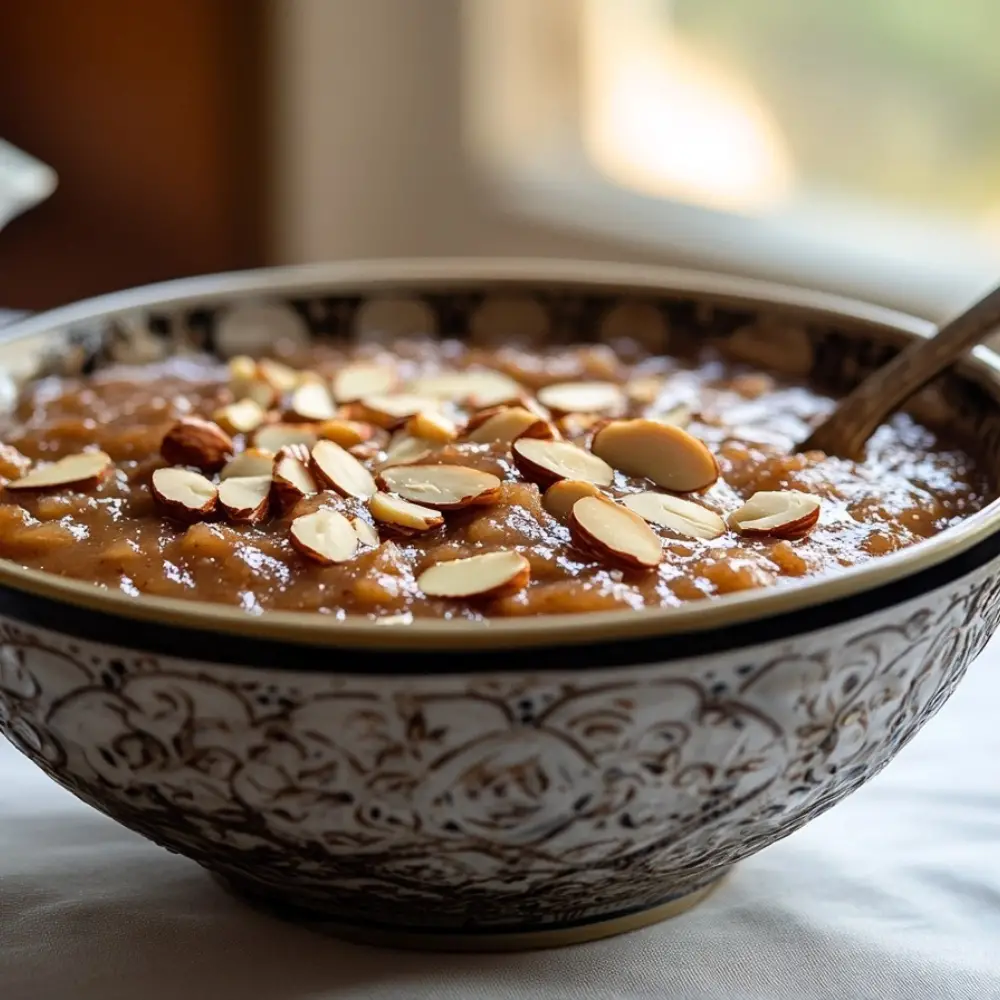A treasured dish of texture and tradition, Yemenite Charoset is a rich, spiced fruit paste that brings deep flavor and cultural depth to the Passover table. Made from dried dates, figs, apricots, and toasted almonds, this version is boldly seasoned with cinnamon, honey, and fresh ginger, then simmered in red wine or apple juice. Its thick, spreadable texture and warm, earthy sweetness make it a standout on a Seder plate or a flavorful addition to any spring celebration, including National Tartan Day with a multicultural twist.
Why You’ll Love This Recipe
Unlike the more familiar Ashkenazi apple-based charoset, Yemenite Charoset is thick, dark, and intensely spiced. The dried fruits offer concentrated sweetness, the almonds add crunch and richness, and the cinnamon and ginger bring bold warmth. It’s naturally gluten-free, dairy-free, and incredibly versatile—delicious with matzo, as a side for roasted meats, or even on a cheese board. It can also be made ahead of time, making it ideal for holiday prep.
ingredients
(Tip: You can find the complete list of ingredients and their measurements in the recipe card below.)
1 cup dried pitted dates
1 cup dried apricots
1 cup dried black figs
1/2 cup coarsely ground toasted almonds
1 teaspoon fresh grated ginger
1 tablespoon ground cinnamon
1/4 cup honey
2 cups red wine or apple juice
directions
- In a small saucepan over medium-low heat, combine the dried dates, apricots, and figs with the red wine or apple juice.
- Bring to a gentle simmer and cook for 10–12 minutes, stirring occasionally, until the fruit is soft and plump.
- Remove from heat and allow the mixture to cool slightly.
- Transfer the mixture to a food processor. Add the grated ginger, ground cinnamon, and honey.
- Pulse until the mixture is well blended but still textured—do not puree fully.
- Stir in the coarsely ground toasted almonds by hand for a nutty crunch.
- Serve in a small bowl at room temperature as part of a Seder plate, alongside matzo, or as a sweet condiment.
Servings and timing
Prep Time: 10 minutes
Cooking Time: 10 minutes
Total Time: 20 minutes
Servings: 10 servings
Calories: 145 kcal per serving
Variations
- Nut-Free Version: Omit the almonds or replace with sunflower or pumpkin seeds for a similar texture.
- Date-Focused: Use only dates for a more traditional, darker charoset.
- Apple Juice for Kids: Use apple juice instead of wine for a family-friendly version.
- Spicier Version: Add a pinch of cayenne or black pepper for subtle heat.
- Silkier Spread: Blend until smooth for a jam-like consistency, perfect for spreading on matzo or toast.
storage/reheating
Yemenite Charoset can be made up to five days in advance and stored in an airtight container in the refrigerator. Allow it to come to room temperature before serving. It does not require reheating and should be served cool or at room temperature. Freezing is not recommended as it may alter the texture of the fruit and nuts.
FAQs
What is charoset traditionally used for?
Charoset is served during the Passover Seder to symbolize the mortar used by the Israelites in Egypt. It’s also enjoyed as a flavorful spread during the holiday.
Can I use fresh fruit instead of dried?
Dried fruit is essential for the thick, paste-like texture of Yemenite Charoset. Fresh fruit would result in a much looser mixture.
Is this version of charoset sweet or savory?
It is sweet and warmly spiced, with earthy notes from the dried fruit and a subtle savory undertone from the toasted almonds and ginger.
Can I make this without a food processor?
Yes. You can finely chop the softened fruits by hand for a more rustic texture, then mix in the other ingredients.
Is it kosher for Passover?
Yes, as long as all individual ingredients are certified kosher for Passover.
Can I use pre-toasted almonds?
Yes, but toasting them yourself just before grinding gives the best flavor and aroma.
How long does it keep?
Stored properly in the refrigerator, it lasts up to 5 days.
What kind of wine is best?
A semi-dry or sweet red wine complements the fruit well, but any kosher-for-Passover red wine will do.
Can this be served outside of Passover?
Absolutely. It works well as a spread, a side dish, or even as part of a cheese platter.
What does Yemenite Charoset pair well with?
Matzo, roasted meats, or cheeses. It also makes a delicious filling for pastries or flatbreads.
Conclusion
Yemenite Charoset is a deeply flavorful and beautifully textured component of the Passover table that speaks to centuries of Jewish culinary heritage. Its rich blend of dried fruits, spices, and toasted nuts makes it more than a symbolic food—it’s a truly delicious and versatile addition to any holiday meal. Whether you’re observing a Seder or sharing a multicultural feast for National Tartan Day, this charoset brings warmth, tradition, and bold flavor to your table.
PrintYemenite Charoset
Celebrate Passover and honor National Tartan Day with this flavorful Yemenite Charoset—a rich, spiced spread made from tender dried dates, figs, and apricots, balanced with toasted almonds, honey, and cinnamon. Simmered with red wine or apple juice, this thick, textured paste is perfect with matzo or as a vibrant multicultural addition to your Seder plate.
- Prep Time: 10 minutes
- Cook Time: 10 minutes
- Total Time: 20 minutes
- Yield: 10 servings
- Category: Condiment, Side Dish
- Method: Blending
- Cuisine: Gluten-Free, Vegetarian
- Diet: Vegan
Ingredients
-
1 cup dried pitted dates
-
1 cup dried apricots
-
1 cup dried black figs
-
1/2 cup coarsely ground toasted almonds
-
1 tsp fresh grated ginger
-
1 tbsp ground cinnamon
-
1/4 cup honey
-
2 cups red wine or apple juice
Instructions
-
In a small saucepan, combine dried fruit and red wine or apple juice.
-
Simmer over medium-low heat for 10–12 minutes until the fruit is soft and plump. Remove from heat and let cool slightly.
-
Transfer mixture to a food processor. Add ginger, cinnamon, and honey.
-
Pulse until thick but still textured.
-
Stir in the toasted almonds by hand for crunch and nutty depth.
-
Serve in a small bowl with matzo or as part of a traditional Seder plate.
Notes
Store in an airtight container in the fridge for up to 5 days. For a smoother version, blend longer or add more juice. You can swap almonds for walnuts or pistachios if preferred.


